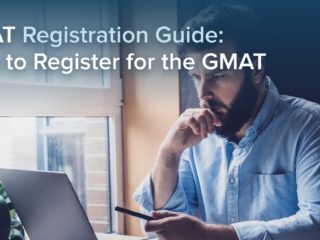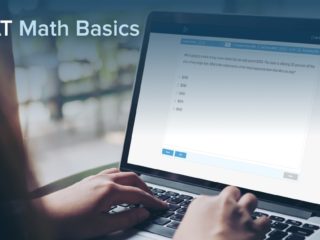| Getting your Trinity Audio player ready... |
Last Updated on October 28, 2025
When you begin preparing for the GMAT, you’ll likely have a different understanding of each topic, ranging from “I know nothing about this” to “I can’t get these questions wrong.” For example, perhaps you’re great at Probability questions: you almost never get those questions wrong under test conditions. However, perhaps you’re underwhelming at Critical Reasoning questions; you almost always get those questions wrong.
As you study a topic, you develop understanding. The more you study effectively, the deeper your understanding becomes. Here’s the problem: many students assume that a deeper understanding of a topic is a deep enough understanding. Put simply, they mistake improvement for mastery. This phenomenon causes stress and confusion about why test-takers are not scoring as high as expected.
I see people demonstrate this pattern time and again. They learn a little bit about a topic, but not enough to know all the ins and outs. Then, they are shocked when they don’t earn a higher score on their practice tests or official GMAT. Sometimes, they reason that the issue is their test-taking ability; they make lots of careless errors. Of course, there is nothing shocking happening, and careless errors are probably not the real issue. Test-takers who have experiences like these are simply less than prepared.
To avoid this pattern, anyone preparing for the GMAT can benefit from understanding the phases of learning. In this article, I’ll review each phase of learning and discuss how to recognize which phase you’re currently in. By the end, you’ll be able to determine where you stand on a given topic and estimate how much more progress is needed to achieve mastery.
Here are the topics we’ll cover:
- Why Knowing the Phases Matters
- Initial Phases: Building Familiarity
- Intermediate Phases: Developing Skill
- Final Phases: Achieving Mastery
- Key Takeaways
- What’s Next?
To begin, let’s discuss why knowing the phases of learning is helpful to your GMAT study process.
Why Knowing the Phases Matters
The situation could unfold as follows: at first, you know nothing about, for example, Number Properties questions. They confuse you to no end, and you consistently get them wrong. So, you begin to study. You do a bit of reading and learn some interesting things about the subject. You watch videos of an instructor solving example questions. You feel better about the topic. After all, it was easy to watch the videos, and the content made sense.
You then solve a handful of Number Properties practice questions, correctly answering half of them. At this point, you get up from your desk to make yourself an espresso. As you’re waiting, you think to yourself, “Wow, I’ve really mastered number properties!”
But have you really mastered number properties? Let’s consider the situation. You did some reading, watched someone else solve some questions, and answered some questions on your own. You’re better at Number Properties now, but you haven’t mastered the topic. So, that positive feeling stems from the progress you made. Three hours ago, you knew nothing about the topic, and now you know a little bit. You’ve accomplished something, and it feels good. This is a great first step! All too often, however, students see this as the final step.
With that thought process, there will be rough waters ahead. What happens when you see Number Properties questions on a practice test? If you have an inaccurate perception of your level of mastery, you might be discouraged by your performance. The problem? Unrealistic expectations. By knowing the phases of learning, you can more easily manage your expectations and use that performance as a learning opportunity.
TTP PRO TIP:
Celebrate your progress, but don’t mistake progress for mastery.
Next, let’s discuss the first three phases of learning.
Initial Phases: Building Familiarity
In these phases, you progress from having no knowledge of a topic to having a basic grasp of the content. Let’s use Critical Reasoning questions as an example topic.
Phase 1: No Knowledge
You know nothing about this particular topic. Moreover, you’ve never seen a Critical Reasoning question before. You’ve never even heard of this type of question. You have no idea what the question is asking you to do, so you can’t even begin to analyze the statements in the passage.
You are in Phase 1 if:
- you have never encountered this type of question
- you can’t identify what the question is asking you to do
Phase 2: Initial Recognition
After some light study, you can recognize Critical Reasoning questions. You know they show up in the GMAT Verbal section. However, you know nothing about the concepts, skills, or strategies used to answer them. You can’t tell an Assumption question from an Inference question. You get nearly 100% of the questions incorrect. If someone were to explain to you how to answer a question, you’d struggle to follow. Your ability to get these questions correct on the test is close to 0%.
You are in Phase 2 if:
- you can recognize the question type
- you do not know how to start answering it
Phase 3: Basic Understanding
After more study, you now recognize particular types of Critical Reasoning questions when you see them. Furthermore, you have begun to learn basic rules, concepts, and procedures to answer these questions. You’re able to better follow someone’s explanations of questions involving the topic. In addition, you can consistently answer the easiest questions, but you are slow and mistake-prone in answering them. You continue to answer almost all of the medium and hard questions on this topic incorrectly.
You are in Phase 3 if:
- you know the basic steps to answer questions of this type
- you can answer some easy questions but struggle with speed and accuracy
KEY FACT:
In the first 3 phases, you progress from having no recognition of a topic to beginning to answer the easiest questions of that type.
Intermediate Phases: Developing Skill
In these phases, you turn your basic understanding of a topic into a more advanced understanding. You start to move towards mastery. Let’s use Rate problems as our example topic.
Phase 4: Easy-Level Mastery
After significantly more study, you fully grasp the concepts, rules, and formulas associated with Rate problems. In addition, you can easily follow an instructor’s solutions to the questions. In other words, you can watch someone else do the work and understand what they’ve done. However, you’re still struggling to correctly answer anything but the easiest of questions; medium and hard questions give you trouble.
You are in Phase 4 if:
- you fully understand the concepts and rules associated with the topic
- you can solve easy questions but struggle with medium and hard questions
Phase 5: Deep Conceptual Understanding
You begin to see patterns, connections, and time/energy-saving moves when you encounter Rate questions. At this point, you have a deep conceptual understanding of the topic and its applications. Converging rates, diverging rates, no problem! You could sit down with someone and accurately explain the major concepts to them. Easy questions are now a piece of cake for you, and you’re getting better at solving medium-level questions. This is especially true when practicing only Rate questions.
However, you often take longer than 2 minutes to solve these questions. You’re accurate but slow. In addition, you regularly get hard questions incorrect. Furthermore, you struggle to answer them in mixed-topic question sets.
You are in Phase 5 if:
- you can solve medium-level questions consistently but slowly
- you struggle with these questions in mixed-topic sets
Phase 6: Medium-Level Mastery
With significantly more study, you now deeply understand the concepts, strategies, and applications of Rate questions. In fact, you could now teach someone a great deal about the topic. When you are solving questions involving only that topic, easy- and medium-level questions are no challenge. You regularly answer them correctly within about 2 minutes. However, hard questions continue to present challenges for you.
You are in Phase 6 if:
- you can explain how to solve questions of this type
- you can handle medium-level questions consistently and quickly but struggle with hard questions
KEY FACT:
In the middle 3 phases, you progress from answering the easiest questions to developing proficiency with medium questions.
Final Phases: Achieving Mastery
In these phases, you put it all together and achieve mastery of a topic under any conditions. Let’s use Overlapping Sets questions as our example topic.
Phase 7: Single-Topic Skill at All Levels
After more study, you have a deeper insight into overlapping sets. You can quickly answer easy, medium, and hard questions correctly when you are solving questions about only overlapping sets. As long as you are solving 30 Overlapping Sets questions, you’re solid.
However, your ability to answer questions correctly declines when you engage in mixed-question sets. To use a baseball analogy, you’re not yet completely comfortable hitting random pitches.
You are in Phase 7 if:
- you can handle questions of this type across difficulty levels.
- you struggle to answer these questions when they are mixed with other topics
Phase 8: Mixed-Topic Skill at All Levels
You’re now able to answer a wide range of questions of various difficulties about overlapping sets. Variations in question language, scope, and form, such as 3-circle Venn diagrams, no longer bother you. In addition, you’re able to comfortably answer questions of this type when they appear in mixed-topic sets. However, you are not able to answer them under the increased pressure of practice tests. Your ability to correctly answer questions involving this topic on the actual GMAT is still in question.
You are in Phase 8 if:
- you are proficient at all difficulty levels and variations of questions of this type
- you can handle these questions in mixed-topic sets but struggle under test conditions
Phase 9: Topic Mastery
After taking and carefully reviewing practice tests, you go back and address any lingering weaknesses you have. Given your progress thus far, you are happy to see Overlapping Sets questions in single-topic or mixed question sets and on practice tests. In answering them, you are efficient and accurate. It’s not that you can get these questions right; it’s that you can’t get them wrong. You have mastered answering questions involving this topic.
You are in Phase 9 if:
- you can solve any possible question on this topic efficiently and accurately
- you look forward to seeing these questions under test conditions
KEY FACT:
In the final 3 phases, you progress from proficiency with medium-level questions to mastery of all questions on a topic under any conditions.
Key Takeaways
To recap, the phases of learning are:
Initial Phases: Building Familiarity
- Phase 1: No Knowledge
- Phase 2: Initial Recognition
- Phase 3: Basic Recognition
Intermediate Phases: Developing Skill
- Phase 4: Easy-Level Mastery
- Phase 5: Deep Conceptual Understanding
- Phase 6: Medium-Level Mastery
Final Phases: Achieving Mastery
- Phase 7: Single-Topic Skill at All Levels
- Phase 8: Mixed-Topic Skill at All Levels
- Phase 9: Topic Mastery
Going from the initial phases to the middle phases takes work and means that you’ve learned quite a bit. Unfortunately, it does not mean that you will correctly answer questions on that topic on your GMAT.
In the final phases, you can be confident that you will consistently correctly answer questions involving a topic. When you’ve reached the mastery phase for all GMAT topics, you can expect an outstanding score.
So, during your GMAT prep, be honest with yourself about which phase you’re in for each topic. Keep moving up the continuum for each topic until you have attained the mastery needed to achieve your goal score. And remember, enjoy the game!
What’s Next?
Interested in moving through the phases of learning more efficiently? Check out these articles about how to start studying for the GMAT and the best way to study for the GMAT.
Need some guidance on studying GMAT Quant or Verbal? Follow these 10 tips to boost your Quant preparation and these 3 tips for practicing Verbal more effectively.
Looking for expert GMAT help? Sign up for a free consultation to see whether private tutoring can help take your GMAT prep to the next level.




Thanks for the info, which i take it as milestones to achieve a great score!
Does each phase correspond to a particular bucket of GMAT score?
Glad this was helpful for you! Unfortunately, there is no exact calculation for which preparation phase corresponds to which GMAT score. However, if you’re interested in figuring out how long you may need to reach your score goal, this article on GMAT preparation timelines will help.
Many Thanks Scott!!, the article you shared with me gave a decent scale to check my progress, taking into account time of preparation and corresponding increase in score
You’re very welcome! Best of luck with your GMAT studies!
This is great piece of information but I have just one question. Once you attain the final stage for one topic and decide to move on with another topic, how you can make sure the topics that you covered already doesn’t bounce you off after some days.. I mean how we can maintain the accuracy in the topics already covered.
Any strategy on that… any way to keep track of it just like you have elaborated steps to track your progress for a topic in hand
You raise a very important issue! Periodically reviewing past topics is an essential part of GMAT prep. This article lays out some simple strategies that will help you stay fresh on what you’ve learned.
Thanks .. I have so much clarity now .. cant thank you enough 🙂
You’re welcome Anurag! Glad it helped you.
Beautifully written
Thank you! Feel free to reach out if you have any questions.
Genius.
🙂